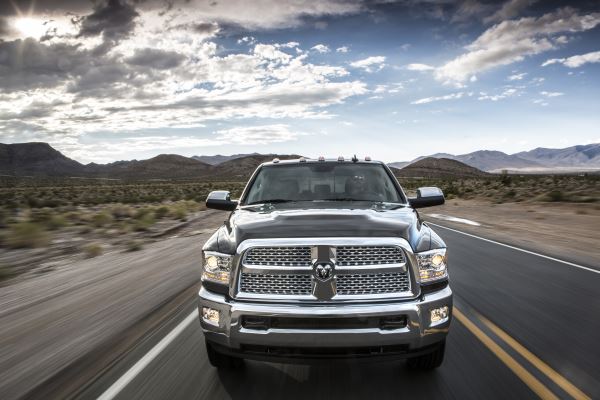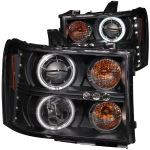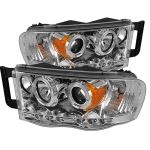While we can debate a lot of things, headlamps on your diesel aren’t one of them. It’s a legal necessity and I doubt anyone would willingly drive after hours without the proper setup. In our automotive history, there were times when people did drive vehicles without headlamps, albeit few of these vehicles were even powered by combustion engines, so speed and traffic were hardly the issues they are today. Technology has certainly evolved and headlamps are mandatory in all countries, which, thankfully, reduces the risk of accidents. According to the United States National Highway Traffic Safety Administration (NHTSA), almost half of deadly accidents occur at nighttime, despite the fact that night driving makes up 25 percent of overall traffic in the United States.
 The first vehicle headlamps were introduced during the 1880s and used acetylene and oil, similar to the old gas lamps. The first electric headlamp was produced by the Electric Vehicle Company in1898, but was so risky most companies couldn’t use it. We can thank Cadillac for bringing us the first modern electric headlamp system in 1912 which, compared to its predecessors, could be used in rain or snow without the risk of getting burned, so progress was being made. Now you are one of the few people that know how headlights evolved from simple acetylene lamps in the 1880s to very complex LED assemblies nowadays.
The first vehicle headlamps were introduced during the 1880s and used acetylene and oil, similar to the old gas lamps. The first electric headlamp was produced by the Electric Vehicle Company in1898, but was so risky most companies couldn’t use it. We can thank Cadillac for bringing us the first modern electric headlamp system in 1912 which, compared to its predecessors, could be used in rain or snow without the risk of getting burned, so progress was being made. Now you are one of the few people that know how headlights evolved from simple acetylene lamps in the 1880s to very complex LED assemblies nowadays.
There’s a lot more headlamp history we could get into, but I don’t want to bore you. The point is, we’ve come a long way. Today you have options when it comes to headlights, each with its own pros and cons. Another exciting piece of news is researchers are continuously working, trying to find new breakthroughs that would obviously make their products more energy- and cost-effective.
Halogen
Halogen headlights are popular primarily because they have a very long life. A normal halogen light bulb has a lifetime of about 1,000 hours under normal conditions, with extremely low replacement costs. However, halogen bulbs are becoming the second option for most, mainly because halogen light bulbs aren’t efficient.
First of all, it is made of a glass envelope capable of resisting very high temperatures, plus a gas—usually iodine or bromine—and a tungsten filament. In order to create light, the bulb receives electricity from the car and heats the tungsten filament to approximately 4,500 degrees Fahrenheit, while the filament begins the incandescence process. The problems take place because while generating the radiating light, the bulb also creates a large amount of heat which is wasted energy. The halogen light bulb comes to the end of its lifetime when the tungsten in the filament evaporates and leaves the filament to reach the glass and causing the light to burn.
Another major problem with halogen bulbs is also the way they respond to various substances. For example, when replacing a faulty bulb, you must avoid touching the glass. Natural skin oil can result in weakening of the lamp, which can cause the bulb to form a bubble, weakening it and leading to its explosion.
Still, halogen light bulbs have a number of advantages, which make them a popular choice.
Pros
- Longer life
- Low cost to produce
- Bulbs are available in a number of different dimensions
- Bright illumination and requires no warm up time
Cons
- Energy is wasted
- Extra care is required while handling
- They become extremely hot
Xenon (HIDS)
Xenon headlights, formally known as high-intensity discharge headlamps (HIDs), are usually defined as a more efficient solution, mostly because of the color temperature and the amount of light they generate. Such a lamp contains xenon gas, hence the slight blue tint of the light. The first xenon headlight appeared on the BMW 7 Series in 1991.
First of all, a xenon headlight is much more efficient when it comes to the amount of light it produces as compared to halogen. Of course, oncoming traffic might not be pleased, especially if the angle of illumination isn't properly configured. According to official stats, a xenon bulb produces 3000 lumens, while a regular halogen bulb generates 1400 lumens. Because of the energy required to run an HID headlight, the HID bulbs do not run on low-voltage DC current, so they require a ballast with either an external or internal igniter, which controls the current given to the bulb. It is also believed that xenon lights have a long lifetime. Estimates tell us to expect a life of around 2,000 hours in normal conditions.
Of course, there are also some setbacks that make HID lights a hassle. For instance, the amount of glare generated will be hard for others drivers on the road. HID lights are more expensive for all stages, including installation, replacing and maintenance. Some xenon headlamps could have a harmful impact on health, as certain versions contain toxic substances, such as metal mercury.
Pros
- Longer lifetime than halogen lights
- More efficient than halogen as they use less power
- Better visibility for the driver
Cons
- Too much glare for the oncoming traffic
- Very high costs
- Possible harmful materials could be used
- Lack of backend compatibility between HID lights and halogen headlamps
- Not always street legal
LED
LEDs are an extremely viable option for your truck. They seem to be the solution for mass-produced cars, but there are also several setbacks that could change your perspective on this type of technology.
One of the best features of LED headlights is the fact that they need very low power to work. Because they do not generate light from heat, LEDs are more energy-efficient than halogen bulbs. A halogen headlight might require 65 watts, where an LED headlight uses 15 watts. Plus LEDs will only get better in the future and due to their small size, producers can create all kinds of shapes and assemblies to match any model.
There are a number of others things to consider though. For example, although LEDs do not emit heat, they create a certain amount of heat at the bottom of the emitter, thus creating a potential risk for connectivity cables. Some avoid using LEDs for headlights especially for this reason, but instead use technology for turn signals, daytime running lights or brake lamps. LEDs are durable, compact and energy-efficient, but they are still relatively expensive.
Pros
- Small size and various shapes
- Very low energy consumption
Cons
- High production costs
- High temperature around adjoining parts
- Not always street legal
Anzo GMC Sierra 2007-2013 Projector Headlights

These projector headlights are designed for innovative style using the latest in C.A.D. technology and equipment. They feature the newest halo design utilizing CCFL technology to insure high brightness, higher efficiency, lower power consumption and longer life. OEM-style weather tight connections and wire harnesses ensure a weather-resistance fit in even toughest climates. A simple plug and play installation allows for custom style, design and additional safety. All AnzoUSA quality products are D.O.T. compliant and backed by a one year warranty. MSRP: $299.99 www.anzousa.com
Anzo Dodge Ram 2010-2013 Projector Chrome Headlights
.jpg_150.jpg)
Built for new model Dodge Ram trucks, these headlights are a great upgrade. Available in Projector with Halo's, LED and CCFL technology featuring G2 Projectors as well as Crystal clear, black and chrome. These powerful Anzo head lamps are brighter than factory head lights and are designed using the latest computer-assisted design technology. All Anzo headlights are subjected to rigorous testing to withstand all sorts of bad weather and bad roads. The improvement in visibility and performance is well worth the investment. MSRP: $499.99 www.anzousa.com
CG Distribution 2009 - 2010 Dodge Ram Projector Headlights with Halo
 A pair of new, high-quality and nice-looking headlights can be that perfect addition to you diesel. It will allow you to drive with more safety and style. These unique lights by CG include everything one can use in lighting manufacturing: focused projector lenses, ultra bright CCFL Halos, and highly efficient LED lights. MSPR: $499.99 www.cgdistribution.com
A pair of new, high-quality and nice-looking headlights can be that perfect addition to you diesel. It will allow you to drive with more safety and style. These unique lights by CG include everything one can use in lighting manufacturing: focused projector lenses, ultra bright CCFL Halos, and highly efficient LED lights. MSPR: $499.99 www.cgdistribution.com
CG Distribution Ford F-250 Super Duty 2008-2010
.jpg_150.jpg) Improve your visibility along with your vehicle’s look by installing this great headlight. The projector lenses will produce a tighter, more focused light beam, while the bright CCFL Halos will make your car more visible to other road users as well as give it a unique, custom appearance. MSPR: $425.99 www.cgdistribution.com
Improve your visibility along with your vehicle’s look by installing this great headlight. The projector lenses will produce a tighter, more focused light beam, while the bright CCFL Halos will make your car more visible to other road users as well as give it a unique, custom appearance. MSPR: $425.99 www.cgdistribution.com
RECON 2011-2014 Ford Super Duty Projector Headlights
.jpg_150.jpg)
RECON has great new projector headlights for 2011-2014 Ford Super Duty F250, F350, F450 and F550. This new smoked black chrome inner housing design features a 40 percent improvement in light output along with a wider, more usable beam pattern as compared to your factory installed OEM headlights.
.jpg_150.jpg)
These projector headlights feature a tougher, cleaner appearance, which will set your truck apart from the crowd. They come with four standard halogen bulbs already installed. However, if you wish to upgrade to HIDs Headlight Bulbs for your projector Low-Beams or High-Beam, you can. MSRP: $649.95 www.gorecon.com
Spyder Halo Dodge LED Projector Headlights
 These headlights are for 2003-2005 Dodge trucks and are designed to improve the look and visibility for your truck. Made by OEM-approved and ISO-certified manufacturers, they are built to directly replace your stock lights. The chrome housing unit holds halogen bulbs so you will be ready to go as soon as the install is over. MSRP: $199.99 www.spyderauto.com
These headlights are for 2003-2005 Dodge trucks and are designed to improve the look and visibility for your truck. Made by OEM-approved and ISO-certified manufacturers, they are built to directly replace your stock lights. The chrome housing unit holds halogen bulbs so you will be ready to go as soon as the install is over. MSRP: $199.99 www.spyderauto.com
Spyder GMC Projector Headlights
.jpg_150.jpg) Specific for GMC trucks built between 2007-2010. These projector headlights have a clear plastic lens and give off an intense beam concentration for increased safety while driving. They are designed to replace your cracked or faded stock headlights and will add style to your truck. Plus they are easy to install. MSPR: $464.99 www.spyderauto.com
Specific for GMC trucks built between 2007-2010. These projector headlights have a clear plastic lens and give off an intense beam concentration for increased safety while driving. They are designed to replace your cracked or faded stock headlights and will add style to your truck. Plus they are easy to install. MSPR: $464.99 www.spyderauto.com